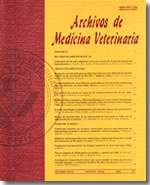Preliminary study of the use of a protocol to assess the welfare of dairy cattle using animal-based observations
Main Article Content
Abstract
The aim of this study was to evaluate the welfare of dairy cows using a simplified protocol of animal-based observations. Twenty-two commercial dairy farms in the province of Valdivia, Chile, were visited once between March and July 2005. The farms were selected considering the willingness of the owners to participate, distance from the university and size of the herd (291±71.6). Five out of the 22 dairy farms grazed their cows all year round; of the remaining 17 farms four of them kept the cows indoors all year round while 13 kept them indoors during the night. Visits started two hours before afternoon milking, and the cows were systematically observed at milking time in order to evaluate physical condition and behaviour. The data was entered into an Excel XP spread sheet. The results for each welfare indicator were grouped into five quintiles (A, top to E, bottom), then the dairy farms were ranked according to the number of indicators in each category. All the farms had at least one indicator in category A. Only one farm achieved five out of seven indicators in category A. The best evaluated indicator was body condition score of the cows, and the worse one was the "flight zone" of the cows. It can be concluded that no farm had consistenly good or bad results when compared to the others, with regards to evaluating cow welfare using animal based observations.

